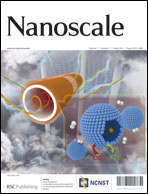Towards directional assembly of hierarchical structures: aniline oligomers as the model precursors†
Abstract
Hierarchical architectures attract a large number of scientists and engineers because of their unique physicochemical properties compared with bulk materials and their precursors. It is believed that intermolecular interactions play a key role in the formation of these hierarchical architectures. However, the principle of coordination of various intermolecular interactions in the self-assembly process is not clear. Here, an aniline oligomer is used as a model brick to study the formation process of well-defined hierarchical architectures, and the directional growth mechanism is proposed. It is assumed that aniline oligomer molecules are asymmetric, and driven by intermolecular attractive forces to aggregate in various manners. Combined with the interactions between the aniline oligomer and molecules from the medium, three-dimensional assemblies, flower-like and urchin-like microspheres, can be formed. The variability and complexity of morphologies produced in the process was analyzed according to the intermolecular interactions, which includes hydrogen bonding, π–π stacking, hydrophobic interaction, etc. The applicability of these special hierarchical architectures, such as in the preparation of superhydrophobic surfaces, is also discussed.


 Please wait while we load your content...
Please wait while we load your content...